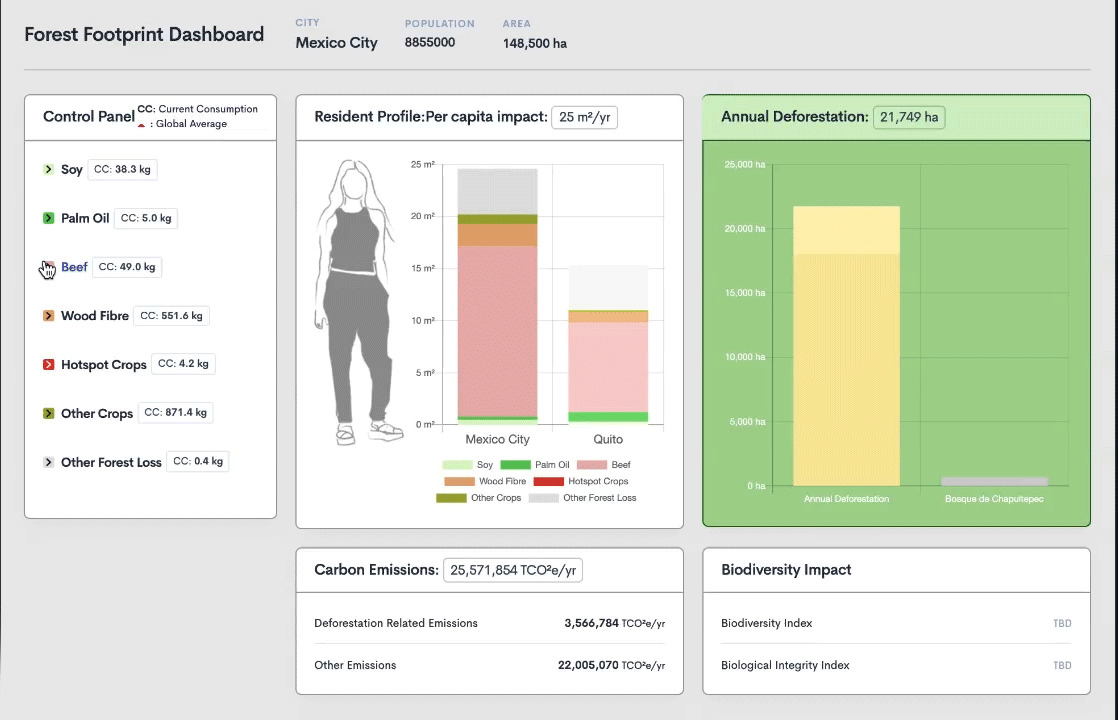
Forest Footprint Action Plan
Leveraging City Consumption to Reduce Global Deforestation
The Forest Footprint Action Plan provides concrete guidance for cities to use their purchasing power and relationship with their residents to purchase forest-positive products. The guide includes resources for further action, research, and advocacy.
Tropical deforestation is a major contributor to climate change and biodiversity loss, and represents 8-10% of annual GHG emissions (3.0-10.3Gt CO2 yr-1). Commercial production of globally traded commodities – such as soy, beef, palm oil, and wood fibre – is now the leading driver of tropical deforestation. To reverse these trends, cities can use their power to stand up for forests, which can in turn help them “build back better” from the current health and economic crises. This Action Plan highlights Innovative plans, enhanced policies and procurement practices, and resident-engagement strategies that have enormous potential to support the conservation and restoration of forests.
Each of these opportunities is supported by case studies, research and resources to aid cities in implementing their plans. The Forest Footprint allows cities to measure the impact in terms of hectares of forest conserved and GHG emissions avoided to be included in climate action plans.
Forest Footprint For Cities
Calculate your city’s tropical deforestation and climate impact
The Forest Footprint will help cities clearly understand, and reduce, the tropical deforestation they are responsible for. Deforestation driven by the consumption of everyday commodities like soy, beef, rubber and palm oil, negatively impacts cities in many ways and is a major contributor to climate change. Tropical deforestation is leading to a biodiversity crisis, shifting rain patterns, and socioeconomic breakdowns, all which can severely impact cities, even when these forests are far away. Now that cities are increasing their focus on climate emissions, the footprint of forest-risk commodities consumed by cities must be better incorporated in climate planning and carbon accounting. The Forest Footprint will provide cities with:
-
Their total deforestation impact and resulting carbon emissions
-
The most significant drivers of commodity-driven deforestation from their city
-
Guidance for mitigation or reversal of these impacts through policy change and resident engagement (coming soon).
Co-development with global leaders Quito & Mexico City
In spring 2020, the Forest Footprint prototype was tested with capital cities Quito and Mexico City. Both cities contributed to rigorous Forest Footprint analyses which led to surprising results, as well as the further refinement of the tool. We are continuing to work with Cities4Forests member cities to co-create ways that this tool can reduce and eventually reverse the devastating impacts we are having on the earth’s remaining tropical forests, climate and biodiversity. Following the positive receptions of these two leading cities, Cities4Forests is looking to expand our network of cities footprinted in the coming years.
Ten opportunities for cities to reduce deforestation
-
Inventory your city’s tropical forest footprint and incorporate into climate and sustainability goals.
-
Upgrade municipal procurement policies to reduce deforestation.
-
Communicate the impacts of consuming forest-risk commodities to city residents.
-
Reduce waste to reduce consumption of forest-risk commodities.
-
Increase accessibility of alternatives to forest-risk commodities.
-
Create a Partner Forest program to support community forest conservation.
-
Incentivize forest-positive innovation in local businesses and entrepreneurs.
-
Regulate forest-risk products using bans, taxes, and incentives.
-
Encourage national/state governments to legislate on deforestation risk commodities.
-
Incorporate nature-based solutions as offsets in climate change mitigation strategies.

The Forest Footprint for Cities' sample dashboard.